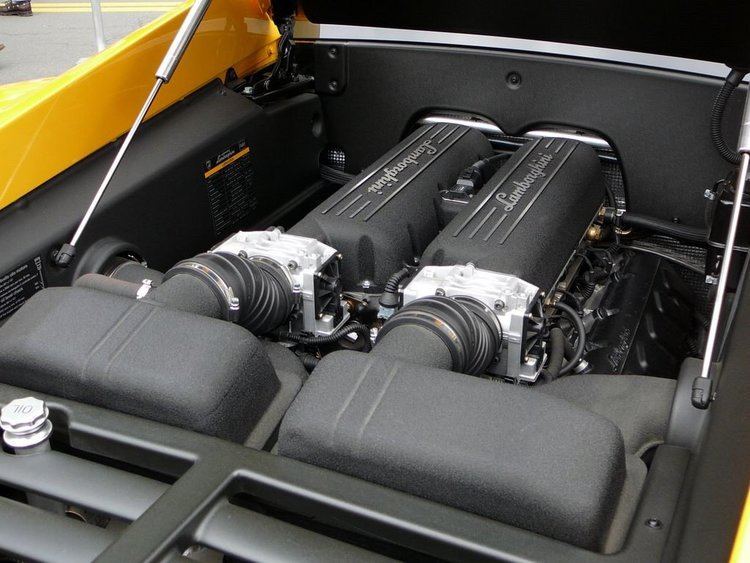The Lamborghini V10 is a ninety degree (90°) V10 petrol engine which was developed for the Lamborghini Gallardo automobile, first sold in 2003.
Developed by AUDI AG, for use in the Gallardo, and the first engine developed for Automobili Lamborghini S.p.A. after they were acquired by AUDI AG - part of the Volkswagen Group.
Its crankcase and cylinder block is built at the Audi Hungaria Motor Kft. factory in Győr, Hungary, whilst final assembly is at Sant'Agata, Italy. It has a 90° vee angle and unusually for a production motor a dry sump lubrication system was chosen to keep the center of gravity of the engine low.
There was also some speculation that the engine block of the original 5.0-litre Lamborghini V10 is closely based on the Audi 4.2 FSI V8, which Audi produces for their luxury cars. However, this was denied by AUDI AG, in their official documentation for their 5.2 FSI V10 engine, as used in the Audi S6 and Audi S8 - the Lamborghini 5.0 V10 has a cylinder bore spacing of 88 millimetres (3.46 in) between centres, whereas the Audi 5.2 V10 cylinder bore spacing is 90 millimetres (3.54 in). The cylinder heads use the four valves per cylinder layout favoured by the Italian firm, rather than the five valve per cylinder variation formerly favoured by the German members of Volkswagen Group - including Audi and Volkswagen Passenger Cars. It was later confirmed by Stefan Reil of Audi's quattro GmbH subsidiary that the new 5.2-litre Lamborghini V10 does share technologies with the Audi 5.2 V10 engine, as is evident by Lamborghini's usage of Audi's Fuel Stratified Injection, and 90 mm cylinder spacing.
engine configuration90° V10 engine;
dry sump lubrication system
engine displacement etc.5.0 — 4,961 cubic centimetres (302.7 cu in); bore x stroke: 82.5 by 92.8 millimetres (3.25 in × 3.65 in) (
stroke ratio: 0.89:1 - undersquare/long-stroke), 496.1 cc per cylinder;
compression ratio: 11.5:1
5.2 — 5,204 cubic centimetres (317.6 cu in); bore x stroke: 84.5 by 92.8 millimetres (3.33 in × 3.65 in) (
stroke ratio: 0.91:1 - undersquare/long-stroke), 520.4 cc per cylinder; compression ratio: 12.5:1
cylinder block and crankcase5.0 — cast aluminium alloy with integrated liners with eutectic alloy; 88 mm (3.46 in) cylinder bore spacing; forged steel crankshaft with split crankpins (to create even 72 deg firing interval with the 90 deg vee-angle)
5.2 — cast aluminium alloy; 90 mm cylinder bore spacing; forged steel crankshaft with shared crankpins (creating an uneven firing interval of either 54 deg or 90 deg separation)
cylinder heads and valvetraincast aluminium alloy, four valves per cylinder, 40 valves total, low-friction roller cam followers with automatic hydraulic valve clearance compensation, chain driven double overhead camshafts, continuously
variable valve timing system both for intake and exhaust
aspirationtwo air filters, two hot-film air mass meters, two cast alloy throttle bodies each with electronically controlled 'drive by wire' throttle butterfly valves, cast
magnesium alloy variable geometry and resonance intake manifold
fuel system5.0 — two linked
common rail fuel distributor rails, electronic sequential multi-point
indirect fuel injection with 10 intake manifold-sited fuel injectors
5.2 — fully demand-controlled and returnless; fuel tank mounted low pressure fuel pump, Fuel Stratified Injection (FSI): two inlet camshaft double-cam driven single-piston high-pressure injection pumps maintaining pressure in the two stainless steel
common rail fuel distributor rails, ten combustion chamber sited direct injection solenoid-controlled sequential fuel injectors
ignition system and engine managementmapped direct ignition with centrally mounted spark plugs and ten individual direct-acting single spark coils; two Lamborghini LIE electronic
engine control unit (ECUs) working on the 'master and slave' concept due to the high revving nature of the engine
exhaust system5.0 — five-into-one exhaust manifolds for each cylinder bank
5.2 — 2-1-2 branch exhaust manifold per cylinder bank to minimise reverse pulsation of expelled exhaust gasses
5.0 power and torque outputs and applications368 kilowatts (500 PS; 493 bhp) @ 7,800 rpm; 510 newton metres (376 lbf·ft) @ 4,500 rpm (80% available from 1,500 rpm) — Gallardo 2003-2005382 kilowatts (519 PS; 512 bhp) @ 8,000 rpm; 510 newton metres (376 lbf·ft) @ 4,250 rpm — Gallardo SE, Spyder, and 2006-2014390 kilowatts (530 PS; 523 bhp) @ 8,000 rpm; 510 newton metres (376 lbf·ft) @ 4,250 rpm — Gallardo Superleggera
5.2 power and torque outputs and applications412 kilowatts (560 PS; 553 bhp) @ 8,000 rpm; 540 newton metres (398 lbf·ft) @ 6,500 rpm — Gallardo LP560/4 - 2008-2014449 kilowatts (610 PS; 602 bhp) @ 8,250 rpm; 560 newton metres (413 lbf·ft) @ 6,500 rpm —
Huracán LP610/4 - 2014-on
As of 2016, all V-10s in the Lamborghini lineup use the 5.2-litre variant. They are:
Lamborghini
Gallardo LP 550-2Gallardo LP 550-2 SpyderGallardo LP 560-4Gallardo LP 560-4 SpyderGallardo LP 570-4 Superleggera Edizione TechnicaGallardo LP 570-4 Spyder Performante Edizone TechnicaGallardo LP 570-4 Squadra CorseGallardo LP 550-2 BicoloreGallardo LP 550-2 TricoloreSesto ElementoEgoistaHuracán LP 610-4 AvioHuracán LP 580-2Huracán LP 610-4 SpyderHuracán LP 610-4Huracán LP 620-2 Super TrofeoAsterion LPI 910-4Audi
R8 V10S8 D3S6 C6(The Lamborghini V10 has also had a placement in the Audi R8, S8 and S6. The 5.2 V10 used in the S6 and S8 is different in several important aspects, namely a less robust crankshaft with a split pin design, cast aluminum pistons, and a traditional wet-sump oiling system, as well as differences in the valvetrain - all of which, combined, result in the much higher RPM red line and specific power output of the Gallardo and R8)

